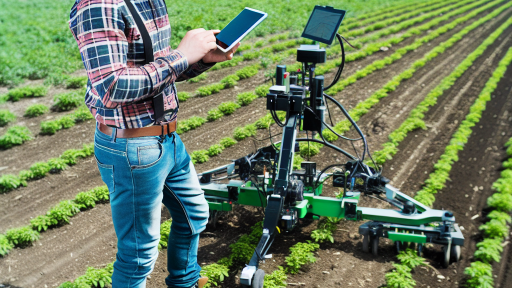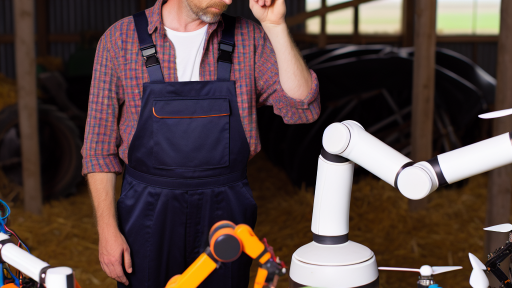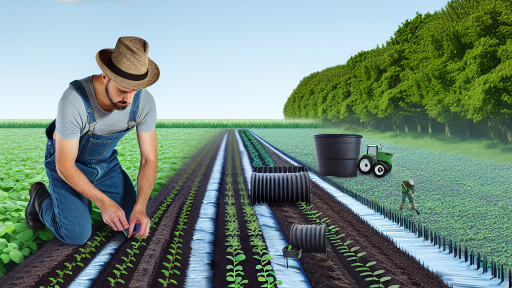Introduction to Sustainable Energy in Agriculture
Sustainable energy plays a crucial role in modern agriculture.
This approach helps farmers reduce their environmental footprint.
It ensures farms can operate efficiently while conserving resources.
The Importance of Sustainable Energy
Sustainable energy sources include solar, wind, and biomass.
These alternatives help decrease reliance on fossil fuels.
Consequently, they lower greenhouse gas emissions significantly.
Benefits for Farmers
Farmers who adopt sustainable energy practices may see cost savings.
Less dependence on traditional energy can lead to lower bills.
Additionally, local energy production enhances energy security.
Types of Sustainable Energy Solutions
Solar panels provide a viable option for various farms.
Wind turbines can harness natural wind resources efficiently.
Biomass energy utilizes organic waste products sustainably.
Challenges in Implementation
Initial investment in sustainable technology can be high.
Farmers may face obstacles in technology access and knowledge.
Moreover, local regulations can impact installation processes.
Transform Your Agribusiness
Unlock your farm's potential with expert advice tailored to your needs. Get actionable steps that drive real results.
Get StartedFuture Trends in Sustainable Energy
Policies increasingly favor renewable energy projects.
Advancements in technology continue to improve energy efficiency.
As a result, more farms are likely to adopt sustainable energy systems.
Benefits of Renewable Energy Sources for Farms
Cost Savings
Renewable energy sources can significantly cut operating costs for farms.
By harnessing solar, wind, or biomass energy, farmers reduce reliance on fossil fuels.
Over time, these savings can be substantial, improving overall profitability.
Additionally, some renewable technologies offer tax incentives or grants.
Energy Independence
Renewable energy fosters energy independence for farming operations.
Farmers can generate their own power, minimizing vulnerability to market fluctuations.
This autonomy allows better control over energy costs and usage.
Furthermore, energy independence enhances resilience during energy supply disruptions.
Environmental Impact
Utilizing renewable energy sources greatly reduces carbon footprints.
This shift contributes to lower greenhouse gas emissions in agricultural practices.
As a result, farms can play a vital role in combating climate change.
Moreover, cleaner energy options promote healthier ecosystems and natural habitats.
Enhanced Agricultural Practices
Renewable energy technologies can improve agricultural techniques.
For instance, solar-powered irrigation systems increase efficiency.
Wind energy can power machinery, reducing diesel fuel dependency.
These innovations lead to sustainable and efficient farming practices.
Community Engagement
Investing in renewable energy can strengthen community ties.
Local farms can serve as examples of sustainability and innovation.
Collaborative projects often arise, fostering local partnerships and support.
Furthermore, this engagement helps educate the community about sustainability.
Assessing Energy Needs: A Guide for Future-Focused Farms
Understanding Farm Energy Requirements
Identifying energy needs is essential for sustainable farm planning.
Showcase Your Farming Business
Publish your professional farming services profile on our blog for a one-time fee of $200 and reach a dedicated audience of farmers and agribusiness owners.
Publish Your ProfileFarmers must consider various factors like crop types and equipment.
Moreover, energy consumption patterns significantly affect budgeting.
Understanding peak demand times can lead to better energy management.
Furthermore, analyzing data can uncover hidden efficiencies.
Evaluating Current Energy Sources
Assessing existing energy sources is a critical first step.
This includes evaluating renewable and non-renewable options.
For instance, solar panels and wind turbines offer eco-friendly alternatives.
Comparatively, fossil fuels may provide immediate but unsustainable solutions.
Hence, a thorough analysis promotes informed decisions.
Identifying Future Energy Needs
Anticipating future growth is crucial for energy planning.
Farmers must estimate future crop yields and livestock demands.
This projection helps determine the necessary energy efficiencies.
Additionally, farmers need to consider technological advancements.
Emerging technologies can greatly influence energy consumption patterns.
Conducting an Energy Audit
An energy audit provides a comprehensive overview of energy usage.
This process identifies areas for improvement and savings.
For effective audits, farmers should engage professionals or use specialized tools.
Data collected during audits offers valuable insights into operational efficiency.
Insights can lead to strategic investments in energy resources.
Implementing Sustainable Energy Practices
Adopting sustainable practices reduces environmental impact.
Farmers should prioritize energy-efficient technologies and practices.
For instance, using LED lighting can significantly lower energy costs.
Additionally, crop rotation and organic farming eventually reduce energy consumption.
Incorporating these practices fosters long-term sustainability on farms.
Monitoring and Adjusting Energy Plans
Ongoing monitoring of energy use is essential for success.
This ensures that energy goals remain aligned with farm operations.
Regular reviews can highlight areas that need adjustment or improvement.
Farmers should stay informed about new energy trends and technologies.
Adapting plans based on data promotes continual energy efficiency.
Explore Further: Robotic Innovations Boosting Farm Efficiency
Implementing Solar Energy Solutions: Steps and Considerations
Understanding Solar Energy Benefits
Solar energy offers numerous advantages for future-focused farms.
It reduces reliance on fossil fuels, thus decreasing carbon footprints.
Additionally, solar installations can significantly lower energy costs.
Furthermore, solar power can provide energy independence for farms.
Assessing Energy Needs
Evaluate your farm’s current energy consumption to identify needs.
Understand peak usage times to optimize solar energy production.
Consider factors such as equipment usage and seasonal changes.
Choosing the Right Solar Technology
Select solar technology that best fits your farm’s requirements.
Photovoltaic (PV) panels are a popular choice for electricity generation.
Alternatively, solar thermal systems can be effective for heating purposes.
Showcase Your Farming Business
Publish your professional farming services profile on our blog for a one-time fee of $200 and reach a dedicated audience of farmers and agribusiness owners.
Publish Your ProfileEvaluating System Size
Determine the appropriate system size based on energy needs assessment.
Use software tools or consult with solar experts for accurate calculations.
Exploring Financial Options
Research available funding options for solar energy projects.
Grants and subsidies can significantly reduce initial costs.
Additionally, consider solar power purchase agreements for affordability.
Finding Reliable Contractors
Choose experienced contractors specializing in solar installations.
Check references and review past projects to ensure quality work.
Request multiple quotes to compare pricing and services.
Ensuring Proper Installation and Maintenance
Schedule installation at a time that minimizes disruption to operations.
Ensure that contractors follow industry standards and safety protocols.
Implement a maintenance schedule to keep the system running efficiently.
Monitoring Performance
Install monitoring systems to track energy production and usage.
Regularly review performance data to identify any issues.
Address problems promptly to maintain optimal efficiency.
Educating Staff and Family
Provide training to staff on managing solar energy systems.
Engage family members in discussions about sustainable practices.
Encourage enthusiasm for solar energy and its benefits.
Discover More: Sustainable Vertical Farming Operations for Modern Farms
Role of Wind Energy in Sustainable Farming Practices
Overview of Wind Energy
Wind energy harnesses the power of wind to generate electricity.
This renewable energy source plays a significant role in reducing carbon emissions.
Farmers can leverage wind energy for various applications on their land.
Integration into Farming Practices
Integrating wind turbines into farming practices benefits both crops and the environment.
Wind turbines can provide a direct power source for farm operations.
They can power irrigation systems, lighting, and other essential equipment.
This reduces reliance on fossil fuels and cuts operating costs.
Boosting Farm Sustainability
Using wind energy contributes to enhanced sustainability practices.
It supports energy independence and resilience against fluctuating energy prices.
Furthermore, wind energy systems can generate additional income for farmers.
Farmers can sell excess energy back to the grid, adding to their revenue streams.
Environmental Benefits
Wind energy significantly reduces greenhouse gas emissions.
This transition helps mitigate climate change effects on agriculture.
Additionally, wind turbines have a low ecological footprint.
They can coexist with agricultural practices without harming crops.
Challenges and Considerations
Despite its benefits, there are some challenges with wind energy adoption.
Initial installation costs can be significant for farmers.
Moreover, location and zoning regulations may affect turbine placement.
Farmers must assess the wind resource availability on their land.
Future Trends in Wind Energy
The future of wind energy in farming looks promising.
Advancements in technology continue to improve turbine efficiency.
As more farms adopt this practice, collaboration becomes key.
Showcase Your Farming Business
Publish your professional farming services profile on our blog for a one-time fee of $200 and reach a dedicated audience of farmers and agribusiness owners.
Publish Your ProfileFarmers can share knowledge and resources to optimize wind energy use.
Discover More: Comparing Traditional and Smart Irrigation Methods
Integrating Biomass and Bioenergy into Farm Operations
Understanding Biomass Energy
Biomass energy comes from organic materials like plant and animal waste.
This type of energy is renewable and can significantly reduce fossil fuel reliance.
Farmers can use biomass to create cleaner energy sources for their operations.
Benefits of Biomass Utilization
Utilizing biomass offers several environmental benefits.
It helps reduce greenhouse gas emissions and promotes sustainability.
This process also supports waste management by converting leftovers into energy.
Farmers can enhance soil health through the application of biochar derived from biomass.
Bioenergy as an Energy Source
Bioenergy plays a critical role in sustainable farming.
It can power machinery, heat buildings, and provide electricity.
Farm operations can integrate bioenergy for greater efficiency and lower costs.
This approach fosters energy independence for agricultural producers.
Implementing Biomass and Bioenergy Systems
Implementing these systems requires careful planning and evaluation.
Farmers should assess available biomass resources on their land.
Additionally, they should consider local energy needs and regulations.
Partnerships with bioenergy companies can also yield beneficial outcomes.
Case Studies of Successful Integration
Many farms have successfully integrated biomass energy into their operations.
For example, Green Valley Farms utilizes livestock waste for biogas production.
This partnership not only provides energy but also improves waste management.
Moreover, Sunny Ridge Farm uses crop residues to produce biofuel.
Challenges and Considerations
Integrating biomass and bioenergy poses challenges as well.
Farmers need to remain informed about the changing regulations.
Cost can also be a barrier for some operations.
Demand for biomass must align with energy production to ensure efficiency.
Future Directions and Innovations
The future holds great potential for biomass and bioenergy development.
Emerging technologies can improve conversion processes and efficiency.
Investments in research will further enhance the integration of these energy sources.
Ultimately, innovation will support the growth of sustainable farming practices.
Explore Further: Cost-Effective Sensor Solutions for Agriculture

Government Policies and Incentives for Sustainable Farm Energy Planning
Overview of Current Policies
Government policies play a crucial role in promoting sustainable energy practices on farms.
These policies aim to reduce greenhouse gas emissions and enhance energy efficiency.
They also support the transition toward renewable energy sources in agriculture.
Financial Incentives and Grants
Financial incentives encourage farmers to adopt sustainable energy solutions.
Grants from local and federal governments help offset installation costs.
For instance, the USDA offers funding for renewable energy projects.
Additionally, farmers may access competitive grant programs for energy efficiency upgrades.
Tax Benefits and Deductions
Many governments provide tax benefits for investments in sustainable energy.
Tax credits for installing solar panels benefit farm operations significantly.
Farmers can also benefit from deductions for energy-efficient equipment purchases.
Showcase Your Farming Business
Publish your professional farming services profile on our blog for a one-time fee of $200 and reach a dedicated audience of farmers and agribusiness owners.
Publish Your ProfileThese incentives improve the economic viability of sustainable practices.
Regulatory Support and Permits
Regulatory frameworks can facilitate the adoption of renewable energy on farms.
Streamlined permitting processes help farmers implement energy projects faster.
Moreover, states often develop renewable portfolio standards to boost clean energy use.
This regulatory support enhances the viability of solar and wind installations.
Educational Programs and Resources
Government agencies offer educational programs to promote sustainable farming practices.
These programs provide essential resources and guidance for energy planning.
Workshops and webinars help farmers understand available technologies and incentives.
Additionally, partnerships with agricultural extension services offer tailored advice.
Incentives for Research and Development
Governments support research into sustainable farming technologies.
They fund projects that explore innovative energy solutions for agriculture.
Such innovations can lead to cost-effective and efficient farming practices.
Therefore, encouraging R&D is vital for long-term sustainability in agriculture.
Case Studies: Successful Implementation of Sustainable Energy on Farms
Solar Power Adoption in Willow Creek Farm
Willow Creek Farm transitioned to solar power in 2020.
This move significantly reduced their energy expenses.
In addition, they cut their carbon footprint dramatically.
By installing solar panels, they produced nearly all their energy needs.
The farm also sells excess energy back to the grid.
Notably, this initiative attracted eco-conscious consumers.
Wind Energy at Green Pastures Ranch
Green Pastures Ranch began harnessing wind energy in 2019.
They installed several wind turbines on their property.
This action provided a sustainable power source for farm operations.
As a result, they reduced reliance on fossil fuels.
Moreover, wind energy helps improve air quality in the area.
This project increased the ranch’s marketability to green consumers.
Biodigesters in Sunny Fields Organic Farm
Sunny Fields Organic Farm implemented biodigesters in 2021.
This technology utilizes animal waste to generate energy.
The process produces both electricity and organic fertilizer.
Consequently, the farm tackled its waste management issues sustainably.
Additionally, they reduced their operating costs significantly.
This innovative approach garnered attention from local agricultural groups.
Empowering Local Communities
These case studies illustrate how farms contribute positively to the environment.
They serve as models for sustainable energy planning in agriculture.
Furthermore, these farms educate local communities on sustainability.
This education encourages more farmers to adopt similar practices.
Ultimately, sustainable energy initiatives build a resilient farming sector.
Challenges and Solutions in Transitioning to Sustainable Energy
Identifying Key Challenges
Transitioning to sustainable energy involves various challenges.
Farmers often face high initial costs for new technologies.
Additionally, infrastructure changes can be complex and time-consuming.
Another challenge is a lack of knowledge about sustainable options.
Showcase Your Farming Business
Publish your professional farming services profile on our blog for a one-time fee of $200 and reach a dedicated audience of farmers and agribusiness owners.
Publish Your ProfileFarmers may feel overwhelmed by energy regulations and requirements.
Accessing Financial Assistance
Financial constraints hinder many farmers from adapting quickly.
However, government grants and loans can alleviate this burden.
Farmers should explore local and state programs for funding.
Additionally, non-profit organizations often offer financial guidance.
Leveraging Technology
Technology plays a crucial role in sustainable farming practices.
Farmers can utilize solar panels for renewable energy generation.
Wind turbines also present an efficient energy solution.
Investing in energy storage systems increases reliability and efficiency.
Furthermore, precision agriculture technologies can enhance resource management.
Building a Supportive Community
A supportive community helps farmers navigate the transition.
Building networks with other sustainable farms can be beneficial.
Sharing experiences and resources fosters collaboration and growth.
Local workshops and seminars can enhance knowledge-sharing opportunities.
Implementing Gradual Changes
Transitioning to sustainable energy does not require immediate overhauls.
Farmers can implement changes gradually to test their effectiveness.
Starting with small modifications can lead to significant improvements.
For example, integrating energy-efficient equipment reduces waste over time.
Engaging with Policy Makers
Engaging with policy makers is vital for sustainable progress.
Farmers should advocate for policies supporting renewable energy access.
This engagement influences regulations that affect their business.
Moreover, participating in community discussions drives change.
Collaboration with local governments often yields beneficial reforms.
Future Trends in Sustainable Energy Technologies for Agriculture
Emerging Renewable Energy Sources
Farmers increasingly turn to solar energy for their operations.
Solar panels provide a clean source of power for irrigation systems.
Wind energy also shows great potential in rural areas.
Farmers can harness wind turbines to generate electricity on-site.
Biogas systems are gaining traction for waste management.
They convert organic waste into useful energy for heating and power.
Energy Efficiency Improvements
Modern farming techniques focus on enhancing energy efficiency.
Smart irrigation systems help in reducing water and energy use.
Precision agriculture uses technology to optimize resource allocation.
Farmers can utilize drones for monitoring crop health effectively.
Energy-efficient machinery also plays a significant role.
These machines consume less fuel and reduce overall emissions.
Integration of Energy Storage Solutions
Energy storage solutions are critical for sustainable farms.
Batteries can store excess energy produced during sunny or windy days.
This stored energy can power operations during peak demand times.
Farmers are beginning to invest in innovative storage technologies.
This trend will enhance energy independence and resilience.
Showcase Your Farming Business
Publish your professional farming services profile on our blog for a one-time fee of $200 and reach a dedicated audience of farmers and agribusiness owners.
Publish Your ProfileAdoption of Smart Technology
Smart farming technology is revolutionizing energy management.
Farmers use wireless sensors to monitor energy consumption closely.
Data analytics help identify areas for energy savings.
Furthermore, integrated software systems streamline energy use.
These advancements lead to cost savings and reduced environmental impact.
Government Policies and Incentives
Government support is vital in promoting sustainable energy practices.
Incentives encourage farmers to adopt renewable technologies.
Grants and subsidies make solar and wind technologies more accessible.
Policies aim to reduce carbon footprints in agricultural production.
Collaborations with energy providers foster sustainable initiatives.
Additional Resources
Institute for Energy and the Environment | Vermont Law and …




